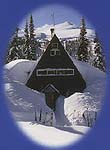 |
Blanket Glacier Ski TripMarch 10-18, 2001 |
Safety Summary
It has become customary on these trips to summarize any safety concerns or problems afterward. This began with the first Fairy Meadows trip which, like most following trips, was to a truly alpine area with many concerns such as avalanches and crevasses. This trip was closer to a simple ski vacation. There were no crevasse hazards, and the few areas where it may have been a slight concern went untravelled due to poor snow coverage and/or poor visibility. The vast majority of terrain is unglaciated. While avalanche hazard was minimal there are a few comments worth making on it, and a couple of group dynamic comments as well.
Avalanche Safety
We had two people with older dual-frequency beacons, which are generally considered obsolete now. There were two different reasons and attitudes behind this. In one case the person does not ski avalanche terrain very often and was ready to purchase a new beacon but hadn't done so yet. This person borrowed a new digital beacon from me for much of the week. The other person was one of those people who just resists change and will probably have the same dual frequency beacon several years from now. At the start of one tour we did a beacon check and I was unable to pick him up when standing more than about 6 ft away. We pointed out to the person that we would be unable to find them if they were to get buried and they didn't seem to appreciate the significance of this fact. If you're going to insist on carrying such an obsolete beacon you should realize that you are only giving yourself a false sense of security. And if you are a partner with such a person in more significant avalanche terrain you should consider the potential ramifications for yourself should you get caught and buried.
Another interesting observation was the transition by the one person from their old dual-frequency beacon to a new digital one. When they first tried my digital beacon they felt extremely uncomfortable with it since it was far different from anything they were accustomed to. After reading the manual and practicing they quickly felt much better with it. This would seem to support my opinion that the new beacons have a much quicker learning curve than the old ones but that they still require a certain up-front investment of time and practice. Don't plan to pick one up from scratch without practice and feel at all confident using it.
One person in the group had just taken a basic avalanche safety course and seemed rather confused about many things. They had taken the CAA course from a school on Mt Hood in Oregon and were reading the book during our week at the Chalet. The book which is given out emphasizes common sense and basic observations over snow pit analysis and tech-talk. This was also the emphasis of almost all of the discussion among the group during the week. At one point this person asked why the course had taught them so much stuff that the book seemed to de-emphasize. Good Question! This highlights a problem with the CAA course which is the topic of much ongoing discussion - that anyone who spends the time and money to take a CAA Level I (professional) course can then teach recreational courses. This is an inadequate prerequisite and has created a situation where many of the instructors using the CAA recreational course materials are driven by a desire for quick and easy profits. All they have to do is take their instructor materials and present the same things to the students. This doesn't require any in-depth knowledge, nor any significant experience, and there are instructors out there with very little concept of what is truly important to convey to their students. This also highlights the fact that students don't always know what is important (which may be why they take a class!) and can go away from a course feeling educated when, in fact, they have not learned the right things.
Group Dynamics
We had one person who insisted on skiing alone, and in many ways they would ski alone even when part of a group. While the rest of the group would be discussing whether or not to continue this person would disappear into the mist. The group then felt compelled to follow since they didn't want to abandon the person. At other times this person insisted on setting out for a tour above treeline on their own, despite the frequent poor visibility all week.
On this trip not much came of this. After a couple days some people just attempted to ski in groups which didn't include the person, without making an issue over it or having any open confrontations. At some point I believe Al (the wise and tactful owner/caretaker and a professional guide as well) spoke privately with this person.
While we have not had any real disasters on any of our trips we have, on most winter trips, been confronted with some of the possible dangers. Including falling through unseen cornices and finding ourselves at the top of unseen cliffs which would have been easy to ski over. Extreme caution is required in these mountains when visibility is poor. To ignore this (by skiing alone, failing to be part of the group and its decisions, and exhibiting a lackadaisical attitude towards the risks) is to invite disaster. One which will effect the entire group, but most of all yourself.
Fortunately the terrain in this area was relatively forgiving.
| |
[Main Blanket Glacier Page] [Organized Trips Page] |
Guiding page
|